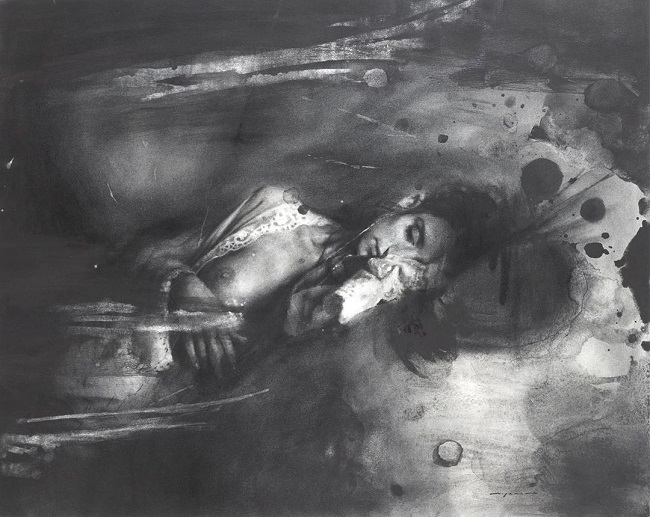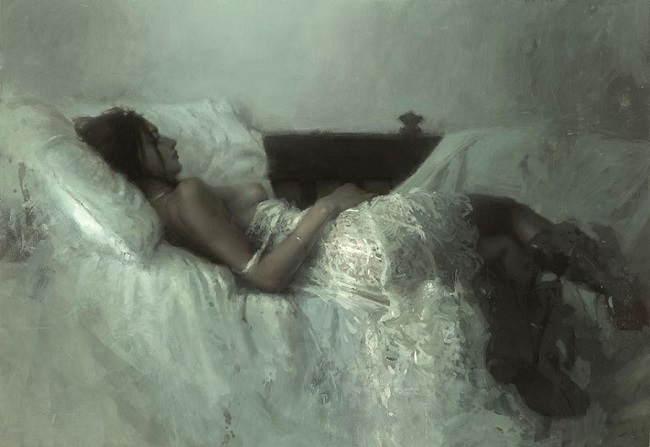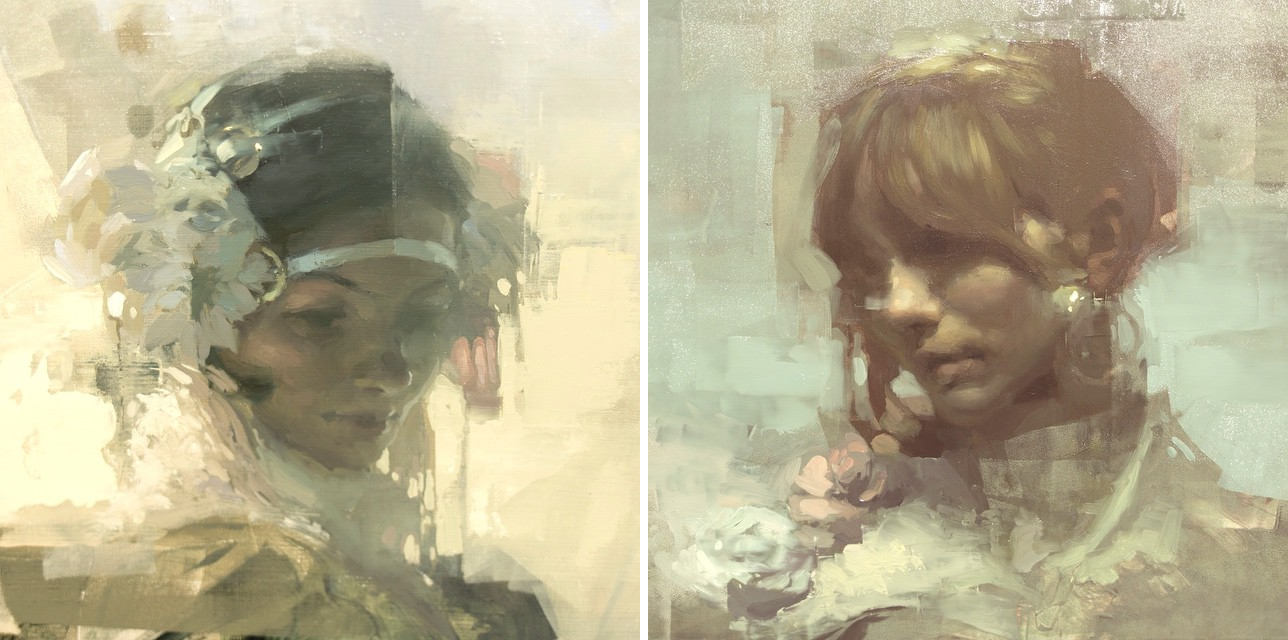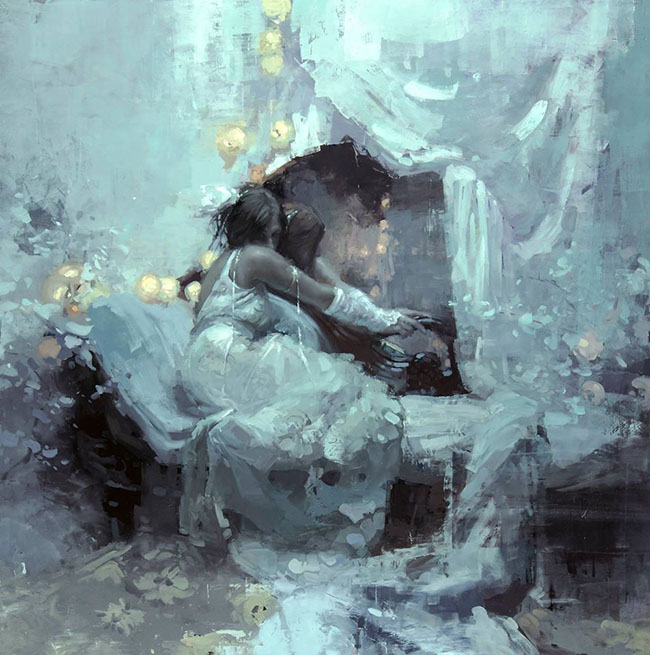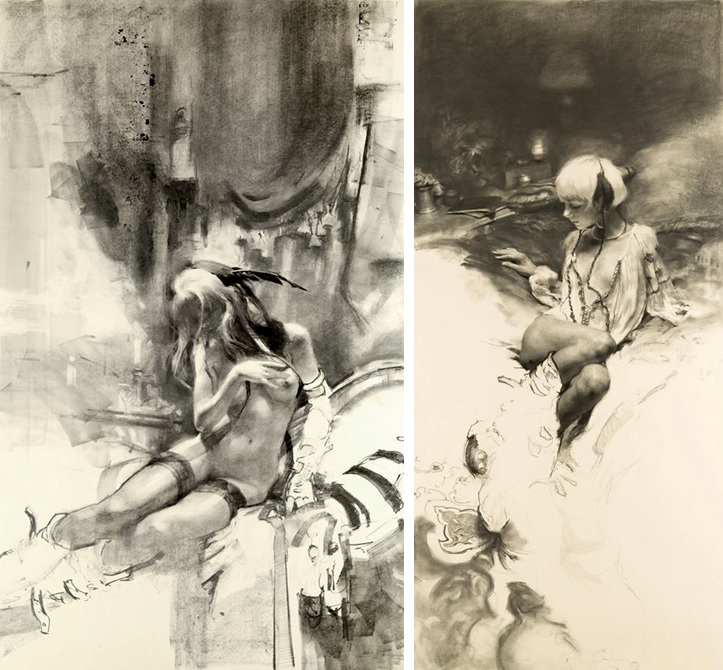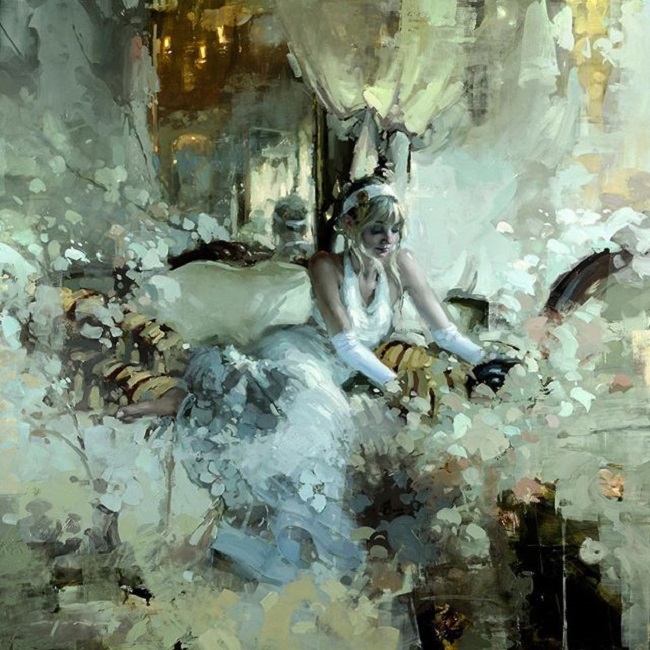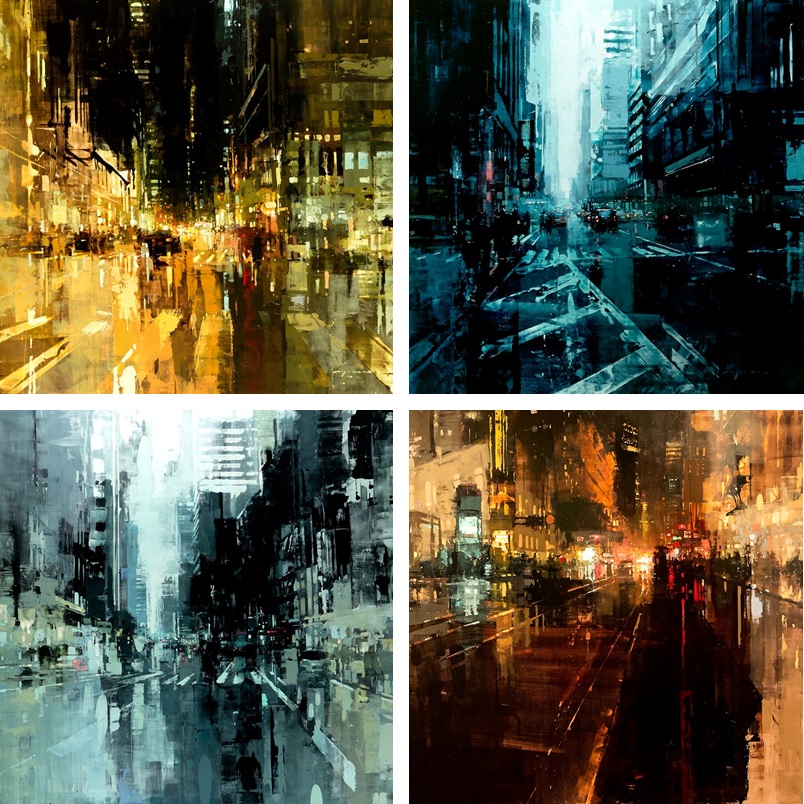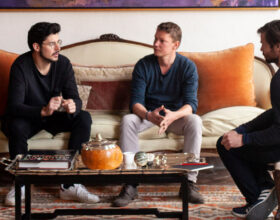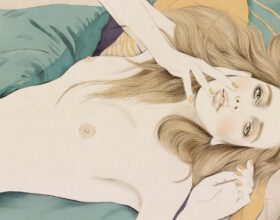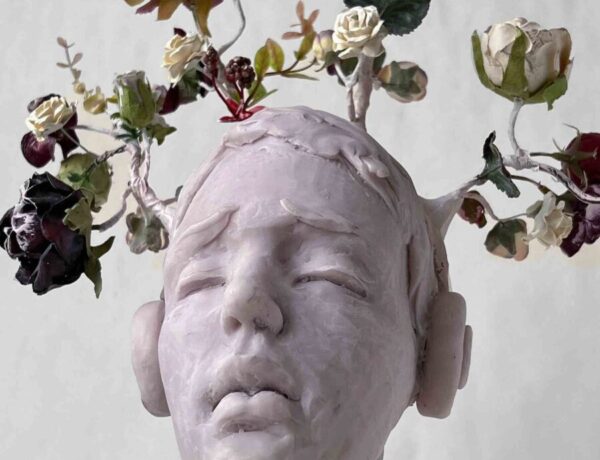Have you ever felt the frustration of having just the right thing, the perfect thing to say at the tip of your tongue, only you can’t express it, can’t shape the words or make the correct phrasing? To have to leave your thoughts or dreams unsaid? This is both the frustration and the genius of American painter Jeremy Mann, the urge… no, more than that… the existential drive to bring perfection to every mark within each of his creations, be they bleak cityscape, lush figurative painting, still life or landscape. That drive can express itself as almost a frenzy when Jeremy is in his creative throes, where the placement of oil on canvas, the shape of each stroke of brush, or roller, or whatever tool is found to be correct, comes together, coalesces into a vision that captures our eye, our imagination, our heart.
Painting, for Jeremy, is an intensely personal process; each completed work, a piece of his soul for us to share. Therefore his need to tell us exactly, precisely, what his innermost being is attempting to express… and the genius of his art speaks to us clearly, the phrasing clear, the prose perfect, and his eloquence knows no bounds.
Interview conducted in conjunction with Jeremy Mann‘s editorial in Issue 14 of Beautiful Bizarre Magazine.
“No Sleep Where Sorrow Woes” for Maxwell Alexander Gallery
“The Quiet Morning’s Light” for Maxwell Alexander Gallery
Your figurative work is unabashedly romantic, and old school romance at that. The feel is lush and decadent ~ 20’s New York or backstage at the Moulin Rouge perhaps… do you have a period you feel best suits your work, that you could see yourself living in?
Well, definitely not THIS one, that is for sure. I can’t really place an exact time frame on when or where I should have been living, though it feels more like living in a memory. Personally, I desire a quieter pace of life, one easily found in mountains, forests and small European villages. I see beauty in all things antiquated, well used and made with love, crafted, educated, and aware. Though being tuned to these sort of notes also makes one well aware of the ugliness and the torment of living in today’s world; digital, crisp, new, lazy, unaware and self-absorbed. However, in order not to be completely insane, I have to work within the times I live.
I use antique cameras and develop the film in my basement to get the quality and accidents reminiscent of memory and hand crafted distress, which are impossible to truly obtain with digital means… though I use a monitor to paint from because it’s a form of “light”, which best emulates actually painting from life. I study, paint and draw from life with models and plein air painting constantly, but always use image references for my studio paintings because my art is a result of both what I see and know, my eyes as well as my mind.
There can be no substitute for the knowledge gained about even abstract fundamentals when learning from life, and those qualities are severely lacking in a world of artists searching for those things relying too much on digital and photo reference. So many of the things I wish to involve in my art is that strange middle space… between a scene that can exist now, but which longs for an older, “better” time now since gone. The decadence helps elevate the paintings emotion above the distress and solemnness, it adds a personal taste of women’s fashion, meant to attenuate their naturally beautiful forms with all myriad things of attraction.
Time for the inevitable inspiration/influences question, let’s try to mix it up a little though ~ who/what are your major non-painting related influences? Is there a soundtrack to your work (Gershwin perhaps?) or a book or film that you would give thanks to in your (insert award name here) acceptance speech?
Dear lord, music and film take up a massive percentage of what I would call my influences. Hell, I have playlists upon playlists designed and oriented to imbue within me certain moods to inflict upon my paintings, blasting at full volume, dancing like a twerp and singing off-key without reservation. So much so that I become outwardly irate for days when a simple “update to new version” of anything makes my playlists nonfunctional, or if I simply can’t find the right music for my temperament.
Very melancholic ambient or classical, dark and morose, beautifully haunting symphonies and simple piano sonatas. Shredding blues guitar and metal music bashing heads (when once I had dreads, now just head banging a balding one) breaking brushes in mid painting while air-drumming during a solo. Whistling along with the singer songwriters of quiet afternoon summer evening songs, and the sweet sounds of some female singer’s sad stories. Ancient scratchy records from hidden French cafés. Complete albums from the Armenian churches. You can’t pinpoint the type, but you can describe the feeling, and it is that feeling that stirs my soul while I paint. I wouldn’t dare pigeon-hole the sounds in my ears to styles or names, there are too many, and too much grey space between.
And then, when I can’t paint anymore, exhausted, mentally, physically, I love nothing more than to turn my subconscious servant to the recharging ecstasies of strange films. The films I enjoy are the meaningful, surreal, filmed and composed with artistry, the ones you must let soak into your eyes, ones that move and confuse but still make absolute sense somewhere within. If you can talk and eat during the film, it’s not usually worth watching for me.
I’m always inspired by the eastern European nations because they hover between familiar and completely otherworldly for me, an Ohio boy, raised in a country who thinks they know everything. And the recent (a few years ago) discovery of some of the surreal films of Czechoslovakia moved me to the core. Again, I could list names, but people put too much weight on a label where its more about the idea. I would give anything to have another 24 hours in a day to pursue film making, where associations and combinations give rise to storytelling and emotions, which I hope to capture somehow in my paintings.
Those sumptuous backdrops for your figures, rich in detail and opulent to the senses ~ are those included in your references or is the reference just the figure with the backdrop the product of your own vision? Are there signature details that you tend to use often?
I struggle with my own preaching often, but that’s a good thing. And “reference is everything” is one of them. The closer my reference is to my idea, the better the painting will possess a springboard to life. I’ve gone so far as to build my own Polaroid cameras in order to get those feelings in my references, and it’s not even the Polaroid that is the best result, but the leftover, often discarded, negative that can be brought back to life, which has the real guts I’m looking for. Life is the best reference. And as I like to combine life with my subconscious or emotive states in my paintings, I need my references to be as true to life as possible, well, at least the life I see in my mind. Therefore, my studio, my house, furniture, knickknacks, lights, all the things which I like, for one reason or another, end up as decorations in my house, and inevitably backgrounds for the paintings. Because I view my life as an artist, and not art as my job, my entirety is devoted to it, there is no line between the two, there is no “end of the workday” for me, it’s not even work, but it is difficult, stressful and exhausting for sure. I often go through phases; I had a mirror phase, a drapery phase, a tassel phase, a silky dress phase, and now progressing to ribbons, transparency and darkness. So my studio, my house, is surrounded and built up with these things you see in the paintings, changing and growing as I do, with objects melding into others, covered by new interests, dust on the old, left for a reason, combining as the remains of the background of my life.
Even, almost especially, the lighting in every room, with every fixture, candle, window shade, time of day, is devoted to inevitably ending up in a painting. I spend more time dressing and undressing the model, adorning her with all kinds of accessories and dresses, fabrics, setting up the backdrops and lighting while she’s nude, taking long exposures and messing with the cameras than the actual time it takes to paint the paintings. Reference is everything, to whatever “reference” may be.
We have many creatives in our audience and they just love the gory details of technique. Can you share your process with us, how you decide on your media and how this has evolved over your career?
Always a hatred for this question, because the answers people are looking for are not actually in the materials. I completely understand the reasoning for WHY people ask this question, why everyone wants to know, and therefore I always love answering it with something else. My MFA Thesis was a proposal where, basically, if I have the utmost amount of knowledge about the fundamentals of art, of life, of whatever I wish to call it, then it truly does NOT matter what is in my hands. which I use to make the painting, it lies within the artist themselves.
Consider this: If an artist paints with the most expensive and well cared for, baby-hair, brushes, using rare flower, hand ground pigments from mountain villages painted upon the rarest and softest high quality linens made of kitten skin, but the painting itself is complete garbage, it is still just that… fucking garbage. All those “quality” instruments not worth a damn. And yet, if another artist, with only a sheet of cardboard, some feces, a mop, and his own two, time-worn hands creates an image, a painting you can call it at that point, that stuns and amazes, moves people to tears, and is known the world over as the most moving image ever created, who is the more profound artist?
It matters not the materials that one uses, it matters that the artist creates marks and paintings using the materials, which produce those marks, which speak to that artist’s soul. Why is it that a first year art student is always told something like “art can be whatever you make it!! But first I need you to go buy these brushes and some canvas.” The key is in the understanding of what you wish to paint, and how to get the materials, which sing the same songs as you, to make those marks, which exemplify that which you wish to paint. You know if a portrait looks terrible. Whether it was painted with a soft filbert, a palette knife, a corncob, a banana or a cat head, it is still terrible. But if you can use a banana to make it correct… was it the banana, or you? Materials are just a thing to learn how to harness. A medium, a thing between the artist and that which they are trying to expose.
For poets, they are words and rhythms. For composers its notes and mathematics. For painters, it’s whatever they can get their damn hands on. If the song is good, would it matter that the composer didn’t have a piano when he wrote it? And if the painting is good, what is the point of the question “but how was it made. What toooooooool!?” The tool of knowledge, ya bastards, the material of experience.
For me, I discovered the rollers when I was mad and tipsy because my childish paintings looked exactly like all the students around me. I went art crazy and painted all night using every material I could think of, find, dig out of the drawers or trash, those which I wasn’t used to using and hunted for hours while painting for the elusive marks which would be solely my own. When I found the next day I had only created a 4-foot piece of garbage containing only one good mark, I was exalted, thrilled. I dug through the piles of crap on the floor to find the jerk, which made that one mark, and it was that roller. I immediately got all the rollers I could think of, experimented, and perfected its use… and I continue to perfect it to this day, over 400 paintings later.
Every day it evolves. As more people are seeing the roller as a way to get marks, I’ve moved on to other techniques involving masking, and immediacy, stains and scrapings using weather stripping, door jams, four-foot rubber rollers, home built four-foot scraper bars, spatulas, razor blades, wine bottles, my own spit, shitty brushes, eight-inch blades… whatever. Once that tool is learned to the point I’m comfortable with the marks I know how to make with it, I retain that weapon, and search for newer marks using different techniques than ever before. Often with failure, but sometimes with a great discovery.
It’s the guts to make those failures that eventually produce some of the most meaningful things for an artist, hell, just for life in general. So my suggestion to anyone is to do just that; have the guts, experiment, but all the while be intelligent and knowledgeable. Despite how it seems out there, it’s quite obvious when art is created with flare and pizzazz and not a lot of intelligence. Lots of smoke, no barbecue.
Your two distinctive streams of work, the figurative pieces and the cityscapes, share stylistic touches but not much else. Do you have a different mindset when you are creating these, a particular mood that is more suited to one than the other??
I feel as though I am an artist without boundaries. I revolt at the thought of being coined a “cityscape painter” or “figure painter.” I actually developed as quite an abstract painter, and have a lot of expertise and love for photography. Every seemingly different subject I approach serves its own purpose. The aggression and grit that exists within my cityscapes evolves from my distaste for modern concrete jungles full of bumbling people. There are certain types of personalities I love to be around, and those characters are not often found within crowds and masses. So cities, fast and heavy with cement grey slate slabs crowded with populations and neon unnatural lights, give me a miasma of distasteful things with which to pour that aggression out upon the panels I paint on. But see it not as simply childish anger, it’s like facing my fears while focusing on foundations.
You see, every cityscape painting in itself, I view and approach as a creation of naturally intangible foundations of art, balance, harmony, composition, color arrangements, line, shape, value and the inexorable qualities of light. To focus upon the, which underlie all things in life, try to see that beauty in something, which fills me with sorrow and depression, and create a painting out of it, is the challenge I impose upon myself. A hundred challenges a day to keep me on my blistered toes.
These things, I learn from the cityscapes, find their way into my figure work. The pace and emotion is different, the adoration of the figure and things like softness and longing are different from the cityscapes, but those foundations are still there. And often, marks from the cityscape, should I have the balls enough to destroy the things I care so much about, find their ways across the figure as well. What I garner from the peace and love I have of nature while plein air painting, can be found in the rendering and edges of the figures, in their flow and her skin, the fabric and light which lays upon her… and in many more places.
The photographs I’ve been taking, the sketching with thin 2b mechanical pencils and solid dark unending 6b heavy pressed outlines also find their way into my paintings, as well as the reductive techniques I use in painting end up with the powders and erasers I use in graphite drawings. They all cross paths through these same hands because they are all just as jumbled and mixed up in my mind. If I could not bounce between subjects, I’d go mad, like not being able to explain how I feel because I haven’t learned the words.



